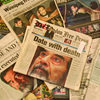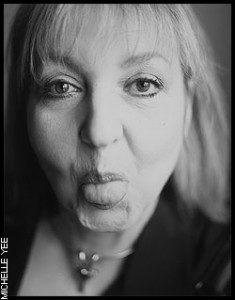Newsworld vs. Newsnet
The good, the bad and a few ugly truths about 24/7 TV news networks
A strong jolt of caffeine does little to prepare me for the shock of seeing a dishevelled Saddam Hussein in the custody of the United States Army – especially on a Sunday morning. I sit on the couch with a notebook and instinctively click to CNN for the latest update. The endless loop of the former Iraqi dictator undergoing the most public delousing in history quickly loses its impact, so I click to find the Canadian reaction. As the news of Hussein’s capture spreads, CBC Newsworld and CTV Newsnet react to the story in surprisingly different ways. Newsnet picks up CTV’s main network feed and runs extended event coverage, cutting away to mandatory two-minute news updates every 15 minutes. Newsworld is much slower to react. Rather than airing stock footage of the recently imprisoned Hussein, the channel aired a documentary of his life. Coverage of Hussein’s capture is an example of all that is good and bad with 24-hour news networks. Much like their dinner-hour counterparts, round-the-clock news services live and die by the rules of the news game: get the story, add context, beat the competition. As CBC Newsworld and CTV Newsnet battle for their share of a limited national audience, each tries to trump the other by imposing increasingly quicker turnaround times on stories. This arena, where speed is paramount, budgets are tight and analysis an afterthought, is a breeding ground for inaccuracy. Despite these apparent drawbacks – and the further issue of whether or not these 24-hour services are even necessary in the first place – viewers tend to turn to news networks first, which makes them influential.
Achieving a balance of content, context and accuracy in a tighter time frame is more difficult than viewers realize, according to two-decade news veteran Susan Ormiston, who has experienced journalism from both sides of the anchor desk. The former CTV Newsnet anchor and current host of CBC News’s Inside Media, says, “You simply have to go on what you’ve observed, your experience and your knowledge of events to try to give [stories] some context in your script.” Cable news networks are only as accurate as the information they gather and tighter deadlines eliminate a critical step between news gathering and going to air: analysis. “You don’t have time to check your facts, you don’t have time to get the other side,” Ormiston says. “And you don’t have the time to get the other best point of view.”
Relying on knowledge and experience translates into doing a lot of research. Kate Wheeler, Newsnet’s daytime anchor, spends almost every spare moment between takes reading up on the day’s events. A seasoned journalist with over 20 years experience, Wheeler says anchoring Newsnet is the most demanding job she has ever had. For eight hours each day she sits with “numb bum” in the glass-walled studio, unable to break free from the camera except to use the washroom or grab a quick meal to bring back to the studio. News doesn’t take a lunch break, so she doesn’t either. “This is my bedtime reading,” she says, lifting a stack of printouts about Pope John Paul II for the next day’s extended coverage of the Pontiff’s silver anniversary celebration, placing them back down on the desk with a thud.
There was a time, not long ago, when news gatherers did take lunch breaks. The world first saw a revolutionary new format in 1980 with the launch of CNN by Ted Turner’s cable media powerhouse, Turner Broadcasting System, Inc. In the quarter-century since, aided by advances in satellite technology and, the rise of the Internet, CNN has become a leader in the news industry. Multi-media communications giant Time Warner, Inc., CNN’s parent company (which acquired tbs in 1996), has bankrolled its round-the-clock news service by creating an international presence in more than 200 countries and territories worldwide. The CNN Newsgroup is a network of more than 700 North American news affiliates packaged and marketed to other networks as CNN Newsource, multi-lingual news Web sites and channels (CNN International), financial news services (CNNfn). It employ 4,000 news staff and journalists at 11 United States bureaus and 36 bureaus around the world.
CNN’s original formula – which pre-dates the all-scandal, all-the-time mentality that exists today – has been copied, adapted and repackaged by other broadcast organizations to fit news markets all over the world. FOX News (CNN’s main competitor), Britain’s BBC World Service and Arab news network Aljazeera have all altered the model for their respective markets. Canada adapted its own version in 1989 with the introduction of CBC Newsworld, Canada’s first 24-hour cable news channel. Partly positioned as a rival to the archetypal CNN, Newsworld’s mission is to provide news to its audience with a distinctly Canadian perspective. Program director of CBC Newsworld Heaton Dyer says that CBC and CNN are “complementary competitors because we won’t try to beat them. We don’t have to because we have our own particular selling point, which is the Canadian perspective.” Newsworld tries to achieve a balanced and diverse line-up, using a three-pillar structure of live broadcasts, specialty programming and documentary features. Dyer says that the model is designed to inspire viewers and incite debate, and is the key to the network’s mandate of placing substance over style. “The Newsworld tagline is ‘Watch, then decide,'” he says. “We are giving people a medium to watch what’s going on, giving them a range of opinions about why something is going on and ultimately it’s up to the viewer to decide.”
Newsworld’s exclusive hold on the market lasted for the better part of a decade, but in a move to satisfy regulations of the Broadcasting Act, CTV launched N-1, a national 24-hour headline news service, in 1997. The re-branded CTV Newsnet runs on 15-minute information “wheels” that continuously update top stories and follow breaking news. “If you want to know what’s happening right now you go to Newsnet,” says executive producer of news syndication and CTV.ca Mark Sikstrom. “If you’re interested in political talk, fashion shows, antique road shows, you can go to CBC Newsworld.” By the terms of its promise of performance stated in a license agreement issued by the Canadian Radio-television and Telecommunications Commission, Newsnet remains faithful to a cyclical format that produces only four news broadcasts per hour. It is permitted to stray from its traditional format under exceptional circumstances, such as the terrorist attacks of 9/11 or the capture of Saddam Hussein – a loophole that irked Newsnet’s competitor from the beginning.
Mere months after Newsnet went to air, Newsworld filed a series of complaints with the crtc, alleging that its competitor was regularly straying from its 15-minute wheel format to produce extended event coverage. A review of Newsnet’s procedures resulted in new rules laid out by the crtc. The channel is now required to interrupt any extended coverage every 15-minutes with a minimum two-minute headline news segment in order to satisfy its original mandate. Newsnet was also granted a five per cent measure of flexibility, which allows the network to air extended coverage up to a maximum of 25 times per week.
Newsworld and Newsnet maintain a 95 per cent difference in programming content. Newsnet runs on a server system that stores in one memory bank pre-recorded material from CTV news sources and items taped in its studio. The format is convenient, but if something is on playback, it can’t be stopped right away. Former Newsnet anchor Avery Haines might consider it a fatal system flaw. The wrong intro – a botched clip in which a stuttering Haines made a joke about her slip-up while ad-libbing politically incorrect remarks about affirmative action – was pulled from the server and placed in the line-up by mistake. The clip went to air and Haines was fired shortly after. On the other hand, Newsworld’s live broadcast strategy balances live newscasts, live events and scheduled live programming with immediate context and debate.
Each network tailors its newscast to viewers with specific needs and lifestyles. According to freelance writer and business consultant Paul Harris, Newsworld skews its long-winded coverage to an older demographic and risks falling into the trap of CNN overkill, where information runs thin and talking heads are fill time. “It [becomes] difficult for the audience to know where facts stop and opinions begin.” John Doyle, The Globe and Mail’s television critic, says that although more people place their trust in Newsworld because of the broader access to information and context, the network runs the risk of turning off viewers with its onslaught of information. “Many news consumers want to get news quickly and will get the context later,” he says. Newsnet is designed for convenience: tune in, get the latest news and tune out. But it can measure up to the competition when it matters, as when news of Hussein’s capture broke.
Newsworld’s stall to action on the Hussein story demonstrates Doyle’s view that the station is slow to break into live events on weekends. Mark Bulgutch, senior executive producer of CBC News and CBC Newsworld, maintains that significant live events trump scheduled broadcasts based on the event’s importance in comparison to the regular scheduled program. But few know that many of Newsworld’s 1,500 live events (such as speeches, scrums and election coverage) are pre-planned, greatly reducing the chance of a gaffe on air. Still, the hesitation in broadcasting live footage of Hussein’s capture undermines Newsworld’s claim of commitment to breaking news.
It is generally easier for both Newsworld and Newsnet to cover domestic breaking news. Once outside Canada, the networks are dwarfed by their international counterparts. Newsworld compensates by utilizing the CBC’s network of national news centres, nine international bureaus and affiliate satellite feeds from CNN and Associated Press Televison News. Newsnet piggybacks on the resources of parent network CTV’s 20 national newsrooms, 10 international bureaus, affiliate satellite feeds and specialty channels Report on Business Television and TSN. Despite this seemingly comprehensive bank of sources, Doyle says the lack of resources is very evident on screen. Compared to the BBC’s deployment of 200 staff to Iraq and surrounding regions at a reported cost of US$15 million, the Canadian effort appeared weak. Parent companies collectively sent 56 journalists and crew to the front (40 for CBC and 16 for CTV). “It is very difficult for a Canadian network to cover a war that American and British networks are covering,” Bulgutch says. “We had three people in three rooms in Kuwait City. CNN had a hotel.” After Canadian crews left the region, CTV and CBC hired contracted freelance journalists and accessed satellite feeds from ABC, CNN and APTN to get live pictures and grainy videophone reports to air.
However restrictive their budgets may seem, both Newsworld and Newsnet have steady and stable revenue sources: cable subscriber fees and advertising. Ian Morrison, spokesman for Friends of Canadian Broadcasting, says cable channels are sold in package deals, so subscribers must pay a set fee to have Newsworld (at 63 cents per subscriber) and Newsnet (14 cents) on their cable dial – whether they want them or not. In 2002, this translated into revenue of approximately $45.5 million for Newsworld and $5.8 million for Newsnet. Also that year, Newsworld scooped up an additional $11.5 million in advertising dollars, while Newsnet’s share was almost exactly half, $5.5 million. Though it is a profitable niche market, these figures appear miniscule in comparison to the CBC main network draw of approximately $284.4 million annually in advertising revenue and program sales. According to Sunni Boot, president of media marketing firm ZenithOptimedia, there is some crossover with the main networks, but some advertisers target this specialized market. For example, there is a preponderance of pharmaceutical ads because the audience is generally older. Even with steady revenue streams, the cost of covering the war in Iraq was prohibitive. That didn’t prevent the two news networks from claiming ratings victories, however. According to Dyer, Newsworld’s audience numbers doubled from seven million to 14 million viewers per week during the war, while Newsnet saw its base audience of four million viewers jump by hundreds of thousands. Both Dyer and Sikstrom admit that Canadian viewers tuned into American networks like CNN and CNN Headline News at the start of the war. In an incredible ratings surge, CNN and Headline News more than quadrupled their average viewers per week, a total of 25 million to a combined audience of 104.4 million between March 19 and March 23, 2003. But many viewers returned to Canadian networks for a less jingoistic perspective. “If Canadians were satisfied with just the CNN’s of the world, there wouldn’t be a need for us,” says Sikstrom. “Canadians want news from Canadians and there are news events they would never see on an American channel.”
The homegrown perspective is a highly valued commodity in the Canadian news industry. It’s even being sold to the American market. Newsworld International (NWI), the Canadian-based international news network owned by Vivendi, reaches 12.2 million American homes through DireCTV’s basic cable package. NWI uses Canadian hosts and incorporates many of Newsworld’s existing shows into a line-up of programs from Japan and Germany. For this use of CBC’s talent and resources, Vivendi pays all of the channel’s operating costs. But as Canadians watch CNN they see stories filtered through a red, white and blue lens. Dyer says CNN allocates numerous resources to its international divisions in a conscious effort to give them a very strong American feel. Only two per cent of content in the American audio-visual system (comprised of broadcasts, video rentals, movie theatres and Internet applications) have an international focus. In Canada, the difference is dramatic – there is a 67 per cent international focus.
Back inside the Newsnet studio, daytime anchor Kate Wheeler is trying to watch a speech by U.S. President George W. Bush on her in-desk monitor, but it’s not working. Bush is supposedly standing on a podium in front of a massive Old Glory backdrop in Fresno, California. One of the control room crew jokes, “Do you think they’re making up for something?” Audio is patched through to Wheeler’s earpiece while she waits for the screen to be fixed. As a technician enters the studio, the monitor magically corrects itself and the director gives the instruction: “Kill Bush in her ear.” The room fills with laughter, but now there’s another problem. Bush’s lips are moving but nothing’s coming out. Silence. “Looks like no one is getting Bush in their ear,” Wheeler says.
All joking about imperial power aside, where the U.S. goes the world media shall follow, and that includes Newsworld and Newsnet. According to Harris, the profusion of American events in the news, coupled with the budget restrictions of Canadian news organizations, narrows the scope of reporting. “There are more copy stories because there are not enough people and not enough time to [get the story] properly,” he says. “Talk shows, particularly on American networks, turn into shouting matches and are of no value to the viewer.” Because of this limited perspective, Harris believes that people will look to other sources for less biased information. Ironically, the slim worldview being force-fed to American consumers – and the world – creates a more friendly environment for Canadian all-news networks.
Lyndsay Carter was the Director of Circulation for the Spring 2004 issue of the Ryerson Review of Journalism.










































